https://www.austinchronicle.com/screens/2012-05-18/pop-culture-thats-a-keeper/
Pop Culture That's a Keeper
Browsing the collectibles at Guzu Gallery
By Marc Savlov, May 18, 2012, Screens
Pop culture is currently undergoing one of its periodic highbrow vs. lowbrow slugfests, and no matter who loses, the audience/player/art lover wins. Or at least that's how it looks from inside the two-month-old Guzu Gallery. Situated right next door to Austin Books & Comics at 5000 N. Lamar, Guzu takes its name from Japanese slang for "a shiftless layabout," "a slacker." And it's oddly apropos that this mashed-up, surrealistically cinematic art-gasm of a storefront was, until recently, occupied by another weirdly American nexus of iconic social statements – namely, a hair salon.
Beware no more of falling follicles, but watch out for the hot pink, queer Imperial Stormtrooper from Suckadelic and take note, especially, of Chilean filmmaker/artist/writer Alejandro Jodorowsky and Zoran Janjetov's epic, oversized graphic tome ("graphic novel" just doesn't cut it here), Before the Incal. And then there are the racks of face-out graphic novels: Bryan Lee O'Malley's Scott Pilgrim series, professional illustrator of unease and discomfort Charles Burns' Black Hole, Daniel Clowes' equally dispiriting/uplifting sad-sack parables, and more than enough Osamu Tezuka (the manga master behind Astro Boy, or, if you prefer the original Japanese, Mighty Atom) offshoots, both literary and figurative, to require the purchase of yet more bookshelves for one's home library and/or figure repository.
Not since Roy Lichtenstein deconstructed Joe Kubert and John Romita have lowbrow and highbrow culture rutted with such spectacular abandon, birthing not the presumed middlebrow mediocrity (although there's plenty of that to go around) but a devilishly viral artistic hybrid – think John Carpenter's The Thing if that film's extraterrestrial metamorph were a resin-based, tentacular artistic movement. Cue Andy Warhol's rictus grin offset by Alastair Cooke looking aghast. (And it's worth noting here that Lichtenstein's I Can See the Whole Room! ... and There's Nobody In It! recently sold at Christie's for a cool $43.2 million.)
What are we to make of this collision of obvious artwork – local rogue Tim Doyle's hyperrealistic dreamscapes are on display in the gallery area in the back of Guzu – and the artistically challenging, if eye-catching, ephemeral weirdness of, say, Frank Kozik's infinitely variable Smorkin' Labbit series of smoking rabbits?
Guzu manager and longtime Austin Books employee Brandon Zuern sums up Guzu's mission statement this way: "We want it to be a place where people can come to see art. Different kinds of art. Screenprints, books on art, and designer toys and urban vinyl."
Which makes Guzu something of a missing link between the late, lamented Austin toy/movie/punk-rock art stores Jim "Prince" Hughes' Atomic City and John Lohse's Gomi (the latter still exists online here: www.gomikitti.blogspot.com) when it comes to niche art that's no longer as nichey but, strangely, ever more Nietzschean – Star Wars Stormtrooper Super Shogun looming over the cash register.
And then there's Guzu's "blind box" selection. What's a "blind box," you ask?
"It's a box with something in it but you don't know what you're going to get," explains Zuern. "Usually you'll know the particular shape of the toy but then they'll have different artists customize the finished look of it. There might be 10 to 20 options, but you don't know which one is inside that specific box."
Kind of like baseball cards or Garbage Pail Kids (or their far superior forerunner, Wacky Packages)?
"Exactly like that. You're hoping to get the rare ones or the really unique ones, but then again, you might get the one you already bought yesterday. Which gives you some trading stock."
The concept of opening up a surprise thing has been around forever, at least since 1912, when the molasses coated popcorn-and-peanuts snack Cracker Jack introduced the concept of a prize in every box (thus fomenting an entirely new brand of kid-based consumerism that would later be picked up by both breakfast cereals and radio serials). But the plasticized, metallic, and occasionally fluffy freak shows Guzu offers have far more in common with Takashi Murakami's anime aesthetics than, say, Sailor Jack's iffy lick 'em/stick 'em pirate tattoos.
Strictly in terms of geek-niche marketing, Guzu Gallery, which serves as a sort of coolness overflow valve for neighboring Austin Books, has a lock on the "everything altogether" chaos theory of toy marketing. And make no mistake: We are living in a golden age of toy art and artistic toys. (I'm pointing the finger at Kozik, Star Wars, and boutique collectible outfit Kidrobot, in that order.)
"It's a great time for toys," agrees Zuern. "If you're like me, you can have your entire home environment covered in plastic shapes in different sizes, some comic book related, some film related, and some of which aren't really related to anything you've probably seen before. They're just weird. But in a really cool way."
So the misfit toys have escaped their island – presumably part of the same archipelago that also housed Godzilla's Monster Island – and have arrived to recontextualize our Western notions of what art is and isn't. Blame the ongoing synergy between comic books, movies, video games, graffiti culture, and forward-looking future nostalgia, and then combine those with the utter ease of use of 3-D printers such as those marketed by Brooklyn-based MakerBot, and the result is a world of toys the world has never even dreamed of before. Suddenly anything is possible ... but is it art?
"Absolutely," says Zuern. "I'm an avid collector of this stuff, and I've got a really extensive collection. They're collectible, they're fun, and they're original. And that sounds like art to me."
Copyright © 2025 Austin Chronicle Corporation. All rights reserved.
